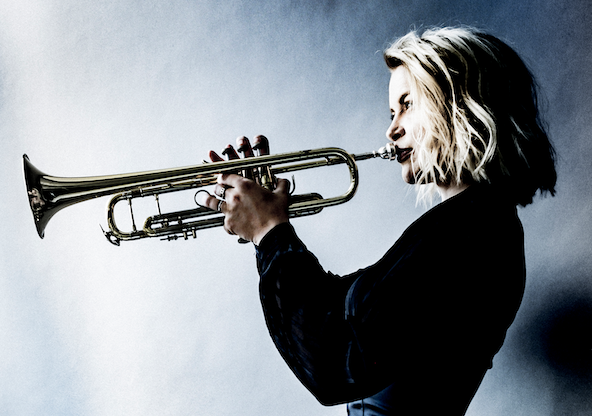Oct 28, 2025 10:47 AM
In Memoriam: Jack DeJohnette, 1942–2025
Jack DeJohnette, a bold and resourceful drummer and NEA Jazz Master who forged a unique vocabulary on the kit over his…

Bria Skonberg adventures beyond her trad-jazz roots on Nothing Never Happens.
(Photo: Dario Acosta)At the same time, the new album provides a measure of social content—an element she said was necessary in the post-2016 world but was lacking on her previous recordings. Given the marketplace demands of big-label production—her last two albums were on Sony Masterworks and OKeh—she self-released the new album.
“My last album was about love and adventure, not without its own depth,” she said. “But to put out another album at this time that doesn’t at least acknowledge what’s going on—that you’re working through it and giving other people a chance to also process it through listening—is a waste of time.”
The process of getting Nothing Never Happens released involved some speed bumps. An attempt at crowd-funding was hindered when the platform through which the album was being financed went bankrupt. However, the steps of assembling the release allowed Skonberg to connect with her fans and shape the final product more directly than she had in years.
The change is evident from the album’s title—a cryptic double-negative that contrasts with the straightforward titles of her recent albums. The new album’s cover art, likewise, is a departure: Rather than a photo of Skonberg, the image is a faceless, slightly abstracted female figure painted by a friend, Lisa Lockhart.
The shift also is clear in the choice of personnel. Unlike her recent albums, her core working group—pianist Mathis Picard, bassist Devin Starks and drummer Darrian Douglas—carries the load. Guitarist Doug Wamble, organist Jon Cowherd and saxophonist Patrick Bartley augment the unit on select tunes.
When Douglas first played with Skonberg seven years ago at New York’s swank Café Carlyle, the playlist consisted largely of unreconstructed early jazz. But, he said, Skonberg has since then expanded her repertoire and approach to encompass more originals and greater stylistic freedom. The transition, he said, was natural and maybe inevitable.
“It’s been kind of a gradual thing,” he said. “People like musicians to fit into these neat little boxes—you only play trad music, you only play music from 1964, whatever—but that’s just not realistic. We grow up listening to music from the ’20s through the current day. It’s difficult to express only one kind of music when you’ve heard Boyz II Men and Louis Armstrong, or Tupac and Baby Dodds. She does a great job of merging everything she’s ever heard.”
Perhaps the clearest manifestation of this idiomatic mixing is found in Skonberg’s mashups, the melding of songs from the 1920s and ’30s with those from the ’60s or later. On Nothing Never Happens, “Blackbird Fantasy” mixes Duke Ellington’s “Black And Tan Fantasy” with Paul McCartney’s “Blackbird.”
Musically, Skonberg said, the process of combining tunes starts with her sitting at the piano, digging into the basic elements of Western music to understand the interrelationships of the pieces at hand: “My mashup process is to analyze the melodic, harmonic and rhythmic content and see where they tie in. It’s a puzzle—I dig puzzles.”
On “Blackbird Fantasy,” the resulting synthesis recalls the gritty chill of Ellington’s slow blues more than the delicacy of McCartney’s ballad, especially when Skonberg gives free rein to her inner growl in a cupped solo that echoes, if faintly, Arthur Whetsol’s 1929 version.
But the lyrics, all McCartney’s, adapt easily to the new setting—owing largely to Skonberg’s vocal, equal parts poignant and piquant.
“Blackbird Fantasy,” she said, was inspired by educational outreach she undertook through a program sponsored by Jazz at Lincoln Center. In it, she made presentations to schoolchildren on jazz and democracy, the Harlem Renaissance and the civil rights era.
“As a Canadian coming to the States,” she said, “it was—and is—such an education and a humbling thing to be trying to relay this information through song to the next generation, people who are the descendants of these exact movements.”

Jack DeJohnette boasted a musical resume that was as long as it was fearsome.
Oct 28, 2025 10:47 AM
Jack DeJohnette, a bold and resourceful drummer and NEA Jazz Master who forged a unique vocabulary on the kit over his…

D’Angelo achieved commercial and critical success experimenting with a fusion of jazz, funk, soul, R&B and hip-hop.
Oct 14, 2025 1:47 PM
D’Angelo, a Grammy-winning R&B and neo-soul singer, guitarist and pianist who exerted a profound influence on 21st…

Kandace Springs channeled Shirley Horn’s deliberate phrasing and sublime self-accompaniment during her set at this year’s Pittsburgh International Jazz Festival.
Sep 30, 2025 12:28 PM
Janis Burley, the Pittsburgh International Jazz Festival’s founder and artistic director, did not, as might be…

Jim McNeely’s singular body of work had a profound and lasting influence on many of today’s top jazz composers in the U.S. and in Europe.
Oct 7, 2025 3:40 PM
Pianist Jim McNeely, one of the most distinguished large ensemble jazz composers of his generation, died Sept. 26 at…

Drummond was cherished by generations of mainstream jazz listeners and bandleaders for his authoritative tonal presence, a defining quality of his style most apparent when he played his instrument unamplified.
Nov 4, 2025 11:39 AM
Ray Drummond, a first-call bassist who appeared on hundreds of albums as a sideman for some of the top names in jazz…